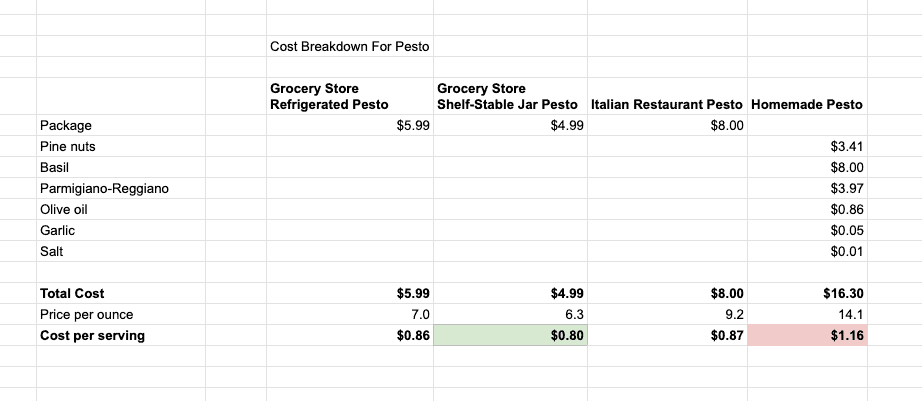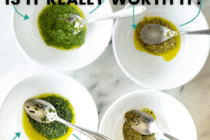This is a guest post by Anna Rider. Anna is a food writer who documents kitchen experiments on GarlicDelight.com with the help of her physicist and taste-testing husband Alex.
I am so excited for the coming summer. After staying away from people for a year, I can’t wait for sunshine, seeing family again, and the summer bounty of fruits and vegetables.
One of the best summery recipes is pesto, the flavor-packed chartreuse sauce that makes everything taste better.
While I’m waiting for basil plants to grow taller than me, how can I satisfy my pesto craving? Should I buy pesto at the supermarket or wait until August to make it?
We can answer this question with another homemade trial!
In case you’re new to the homemade trial series, we pick a food and make it from scratch. Then we compare the homemade version to the store-bought varieties in the categories of TIME, COST, NUTRITION, and TASTE.
Is it worth making pesto at home? Let’s find out!
Anna’s Version
Pesto is a flexible recipe with dozens of ways to prepare it.
The traditional Genoese method of making pesto is to pound the ingredients (the word “pesto” means “to pound” in Genoese) with a mortar and pestle until you get the bright and fragrant sauce that we know and love.
Energetic cooks willing to supply the elbow are welcome to try the classic method.
With our modern conveniences, I make my version using a food processor because it’s quicker and easier.
For this homemade trial, we’re sticking with the textbook pesto. That’s 7 ingredients. Basil, pine nuts, cheese, garlic, salt, and pepper (optional) are blended together while olive oil is slowly drizzled into the mixture.
Since we’re competing with higher-end store-bought pesto, I’m making an A+ effort by using premium ingredients. Let’s see if we can beat out the store-bought options.

Homemade Classic Basil Pesto

Equipment
Ingredients
- 6 ounces fresh basil leaves, 3 bunches or 6 cups
- ½ cup pine nuts, about 2.7 ounces
- ⅔ cup grated Parmigiano-Reggiano cheese, about 2.7 ounces
- 1 clove garlic
- ¼ teaspoon salt
- ⅛ teaspoon freshly ground black pepper, about 3 twists of the grinder
- ¾ cup extra-virgin olive oil, more if needed
Instructions
- Toast the pine nuts until golden brown. Place the pine nuts in a pan over medium-high heat. Continually shake the pan to ensure even toasting. Remove from heat when the pine nuts show brown spots, about 5 minutes. Put the pine nuts in a bowl to cool down.
- Remove any remaining stems from the basil leaves. Rinse the leaves to remove dirt and debris. Gently pat the leaves dry.
- Peel and mince the garlic. Set aside.
- If using a block of Parmigiano-Reggiano cheese, grate the cheese using a box grater or the grater attachment (also called shredder disc) on your food processor. Leave the grated cheese in the food processor bowl.
- Make sure the pine nuts are cool (so they don’t melt the cheese). Add the pine nuts and minced garlic to the food processor bowl.
- Using the S blade, pulse the food processor 5 times to combine the cheese, pine nuts, and garlic.
- Add the basil leaves to the food processor bowl.
- Drizzle the olive oil slowly into the chute of the food processor while the food processor is turned on. The basil leaves should get chopped up and combine with the other ingredients. If the food processor is chopping too quickly, you can pulse instead. Continue until the basil leaves turn into big green flecks (similar to the size of dried oregano).
- Add the salt and pepper. Pulse the pesto 3 more times to combine the salt and pepper. The pesto is ready.
Nutrition
Did you make this recipe?
Tips for Making Pesto

While the food processor is an incredible labor-saving device, it can move too fast for my liking. If you’re struggling to keep up when pouring in the olive oil, use the pulse button for a slower pace.
You can vary the pesto recipe by using different ratios of ingredients. If you prefer pesto that’s more herby, reduce the amount of pine nuts and cheese (or add more basil). Marjoram, parsley, and wild garlic (a.k.a. ramps) are common replacements for basil. Check out the end of this article for a list of pesto variations that Nick published.
My pesto recipe uses fresh basil leaves, pine nuts, and Parmigiano-Reggiano (the real deal!). These are high-quality but pricey ingredients.
To stretch your dollar farther, substitute half the basil with baby spinach. You can use walnuts, pecans, cashews, and other kinds of nuts instead of pine nuts.
Domestic Parmesan or another hard cheese usually offers big cost savings over using Italian DOP cheeses.
What’s the difference between Parmigiano-Reggiano and Parmesan?
DOP (also called PDO, “protected designation of origin”) cheeses like Parmigiano-Reggiano and Grana Padano carry bigger price tags because there are European Union controls to ensure these products come from a specific region in Italy and are manufactured using traditional methods.
Can you taste the difference?
I did a blind taste test and the answer is a big YES!
But that doesn’t mean you have to splurge. You’ll save big with a domestic parmesan, and the flavor will be very close to using Parmigiano-Reggiano.
Another way to save: buy a block of cheese and grate it at home instead of buying the pre-grated stuff. Home-grated cheese tastes fresher, and you can ensure there are no added fillers like potato starch to prevent clumping.

Last tip, if you plan on freezing the pesto or refrigerating it for longer than 1 week, transfer the pesto to an airtight container and cover with 2 tablespoons of additional olive oil over the top of the pesto to keep it fresh and green.
Let’s dive into comparing the homemade pesto to the store-bought varieties.
The Competition
There are 2 kinds of pesto from the grocery store:
1) a refrigerated option sold in the deli section, and
2) many shelf-stable jars of pesto sold next to boxes of dry pasta.
There’s a wide range of prices for shelf-stable pesto. On the cheaper end, you can buy pesto for $2.49 for 7 ounces. On the higher end, you can find $6.99 and more for the same quantity.
The biggest difference seems to be the ingredient list. The cheaper pesto sauces contain canola and soybean oil. The extra-virgin olive oil appears way down the ingredient list. Same with using walnuts and almonds instead of pine nuts.
I picked the only refrigerated pesto option and a mid-range shelf-stable jar of pesto that had olive oil as one of the first ingredients.

To round out the competition, I bought primo pesto from an Italian restaurant in Boulder. Il Pastaio sells fresh noodles, ravioli, sauces, and desserts to take home for cooking. Their house-made pasta is incredible. Oof, this is going to be stiff competition.

TIME
The homemade pesto took about 10 minutes. It could have gone faster if I didn’t toast the pine nuts. The store-bought versions take no time except for grocery shopping (which the homemade version requires too).
It’s a TIE between all the store-bought options in the category of TIME.
COST
The homemade pesto was way more expensive than the store-bought kinds. This makes sense because I didn’t buy ingredients in bulk and chose to use the best-quality ingredients (no canola oil or walnuts).

The shelf-stable pesto is the cheapest. Like the cocoa mix in the hot chocolate comparison, this makes sense because there’s no extra cost for refrigerated transportation and storage.
Most shelf-stable pesto options would be much cheaper than the one I bought because they use frugal ingredients (like soybean oil).
What’s shocking is that the restaurant pesto is almost the same price as the refrigerated one. I assumed the restaurant pesto would be more expensive.
I’m giving the WIN to the shelf-stable version in the COST category.
NUTRITION
Many of the homemade trials, like the chocolate cake and pizza dough trials, show there’s not much nutritional difference between the store-bought and homemade versions. Pesto follows this trend, except you can cut down on the amount of salt if sodium is an issue for you.

Unfortunately when I asked the restaurant for an ingredients list and a nutrition facts label, they told me they couldn’t provide them for me. (Crafty! I’ll never find out how they make their sauce so tasty.)
I’m going to call the NUTRITION category a TIE for all the pesto choices.
TASTE
I turned to my trusty neighbors again to help me with a blind taste test (they were the taste judges in the pie crust trial, fruitcake trial, and hot chocolate trial).
My neighbor disliked the refrigerated pesto. She said it has a weirdly thick texture and tastes like there was cream added (this wasn’t a compliment).
She said the shelf-stable pesto was OK but it tasted like tapenade. I think it might have been the citric acid in the shelf-stable pesto that acts as a preservative and gives it a lemony flavor.
Her and my favorites were the homemade and the restaurant pesto.
She liked the rich cheese flavors in the homemade pesto but it lacked the “wow” factor that the restaurant pesto offered.
I agree. The first bite of the restaurant pesto delivers a flavor bomb and makes your eyes pop out. While we both really liked the homemade pesto, it comes in second place to the restaurant pesto.

It hasn’t happened in a while. But this time, the store-bought restaurant pesto is the WINNER of the TASTE TEST.
THE VERDICT
Here’s the tally (TIME => tie between all the store-bought versions, COST => shelf-stable, NUTRITION => tie between all the pesto options, TASTE => restaurant pesto).

Based on the results, I consider the RESTAURANT pesto the winner of this homemade trial!
The restaurant pesto was cheaper than the homemade version and handily beat the other store-bought varieties in the taste test.
However, Alex reminded me that most Macheesmo readers don’t live in Boulder and wouldn’t be able to easily buy this restaurant’s pesto. While that’s true, many of us live close to a reputable deli or Italian restaurant that sells house-made pesto.
If you don’t have access to restaurant- or deli-made pesto, the homemade pesto is the next best thing.
If you’re growing basil this summer and have massive quantities to use up, making homemade pesto is a no brainer! Homemade pesto tastes fabulous and is a great way to preserve excess basil for a long time in the freezer (plus homegrown basil makes homemade pesto much cheaper).
Does your homemade pesto taste better than any store-bought versions? Do you have a nice deli close by where you buy fancy Italian sauces? Leave a comment to let us know.
Different Variations on Pesto!
Looking for exciting ways to spruce up traditional pesto? Check out these pesto variations using different herbs/vegetables, cheeses, and nuts.
- Arugula Walnut Pesto
- Pestachio (Get it? Pistachio pesto)
- Havarti Mac and Cheese with Spinach Pesto
- Watercress Pesto is the Besto
- Mint Pesto


